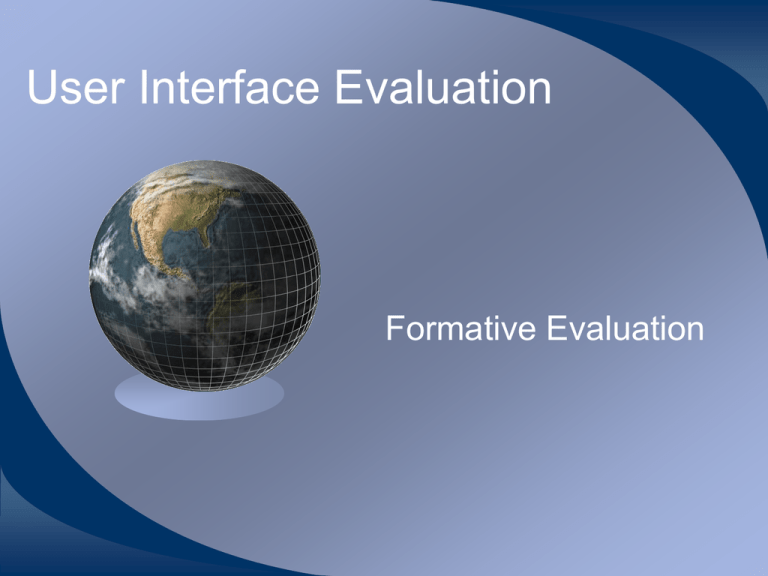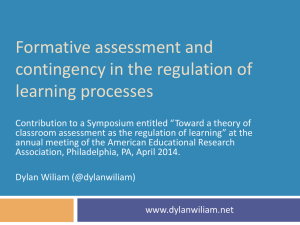User Interface Evaluation
advertisement

User Interface Evaluation Formative Evaluation Summative Evaluation Evaluation of the user interface after it has been developed. Typically performed only once at the end of development. Rarely used in practice. Not very formal. Data is used in the next major release. Formative Evaluation Evaluation of the user interface as it is being developed. Begins as soon as possible in the development cycle. Typically, formative evaluation appears as part of prototyping. Extremely formal and well organized. Formative Evaluation Performed several times. o An average of 3 major cycles followed by iterative redesign per version released o First major cycle produces the most data. o Following cycles should produce less data, if you did it right. Formative Evaluation Data Objective Data o Directly observed data. o The facts! Subjective Data o Opinions, generally of the user. o Some times this is a hypothesis that leads to additional experiments. Formative Evaluation Data Quantitative Data o o o o Numeric Performance metrics, opinion ratings (Likert Scale) Statistical analysis Tells you that something is wrong. Qualitative Data o Non numeric o User opinions, views or list of problems/observations o Tells you what is wrong. Formative Evaluation Data Not all subjective data are qualitative. Not all objective data are quantitative. Quantitative Subjective Data o Likert Scale of how a user feels about something. Qualitative Objective Data o Benchmark task performance measurements where the outcome is the expert’s opinion on how users performed. Steps in Formative Evaluation Design the experiment. Conduct the experiment. Collect the data. Analyze the data. Draw your conclusions & establish hypotheses Redesign and do it again. Experiment Design Subject selection o o o o o Who are your participants? What are the characteristics of your participants? What skills must the participants possess? How many participants do I need (5, 8, 10, …) Do you need to pay them? Experiment Design Task Development o What tasks do you want the subjects to perform using your interface? o What do you want to observe for each task? o What do you think will happen? o Benchmarks? o What determines success or failure? Experiment Design Protocol & Procedures o What can you say to the user without contaminating the experiment? o What are all the necessary steps needed to eliminate bias? o You want every subject to undergo the same experiment. o Do you need consent forms (IRB)? Experiment Trials Calculate Method Effectiveness o Sears, A., (1997) “Heuristic Walkthroughs: Finding the Problems Without the Noise,” International Journal of Human-Computer Interaction, 9(3), 213-23. Follow protocol and procedures. o Pilot Study Expect the unexpected. Experiment Trials Pilot Study o An initial run of a study (e.g. an experiment, survey, or interview) for the purpose of verifying that the test itself is well-formulated. For instance, a colleague or friend can be asked to participate in a user test to check whether the test script is clear, the tasks are not too simple or too hard, and that the data collected can be meaningfully analyzed. o (see http://www.usabilityfirst.com/ ) Data Collection Collect more than enough data. o More is better! Backup your data. Secure your data. Data Analysis Use more than one method. All data lead to the same point. o Your different types of data should support each other. Remember: o Quantitative data tells you something is wrong. o Qualitative data tells you what is wrong. o Experts tell you how to fix it. Measuring Method Effectiveness Conclusions The data should support your conclusions. o Method Effectiveness Measure Make design changes based upon the data. Establish new hypotheses based upon the data. Redesign Redesign should be supported by data findings. Setup next experiment. o Sometimes it is best to keep the same experiment. o Sometimes you have to change the experiment. o Is there a flaw in the experiment or the interface? Formative Evaluation Methods Usability Inspection Methods o Usability experts are used to inspect your system during formative evaluation. Usability Testing Methods o Usability tests are conducted with real users under observation by experts. Usability Inquiry Methods o Usability evaluators collect information about the user’s likes, dislikes and understanding of the interface.



